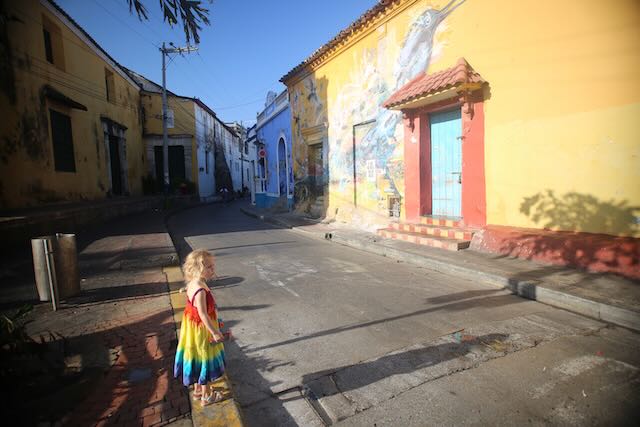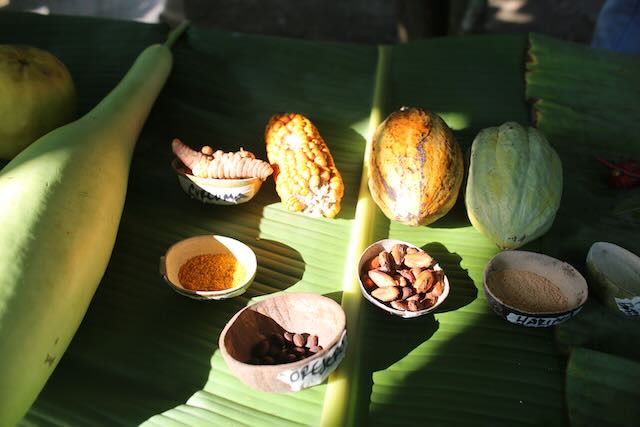I open up my journal to the page where I pressed a butterfly pea flower. The flower is so thin and delicate it is stuck to the opposite page. I pry the petals with my fingers as carefully as I can, and it flutters down to where I had pressed it. I feel that ping of sadness and joy seeing it there, and remembering the garden where I plucked it, a smiling woman named Adamaris who has been growing the flowers to earn money, and also to make a tea for her husband who suffers from depression. We stood inside their small house briefly making introductions, a tv on in the corner, a bit of light filtering in onto a wooden couch.
We stop to look at the sunrise along a tributary of the Rio Magdalena. Elegant white birds flutter by as if in slow motion - I call them egrets, wanting to use a word other than 'bird' but know I am probably far off. I am not a birder, but maybe someday I'll learn. I try to change lenses and fling one accidentally into the trash alongside the road; I think about how my dad used to take us to the dump to search for toys. A few motorbikes whiz by. We bask in the pink.
Arriving to the farm felt like a familiar homecoming I've never had. Like a passage in a Garcia Marquez book I read in high school and am transported to in real time through some magical realism time-machine.
“But she persevered, overcome by the growing anxiety, and little by little she was getting back her ancestral appetite, the taste of primary minerals, the unbridled satisfaction of what was the original food.”
- Gabriel Garcia Marquez, One Hundred Years of Solitude / Cien Anos de SoledadWe had to park the car along the dirt road about a quarter mile from the homestead, as the bridge was out, and there were some gentleman digging a hole. We hiked the short distance, passing by a tree that lazily dropped giant white flowers that looked like the poof for a lady's face powder. Or else an anemone, tendrils waving. A green field lay fallow alongside the road, and blue green mountains rose peacefully in the distance. The group that welcomed us were all farm hands or managers, gathered around a long table covered in banana leaves and the produce from the land - fruits, beans, nuts, seed pods and spices. A mind boggling array of edible biodiversity. I gawk in awe for a while, as they serve us a drink made of corn, cocoa and cinnamon - mild and a little thick. Served in a cup made from the husk of a fruit here.
After an awkward round of introductions that felt a bit like a church service, we have breakfast - cassava, squash, fresh cheese, green papaya shredded and cooked with achiote oil, and the key condiment that is called suero - aka sour cream - which everyone raved about but I found to taste a bit too much like barnyard. Maybe it was the heat?
At high noon, the most illogical time to go out into the field, we go out into the field to learn about the achiote harvest. Achiote, also called 'annatto' is a seed from Bixa orellana, a deep burgundy red, with an aroma at once earthy and vegetal, reminiscent of wet earth and nutmeg. The spice is most valued for the golden color it brings to food, especially soups and rice dishes. It's known across Latin America and the Caribbean and is produced in varying qualities. But my friends say the organic achiote from here in the Montes de Maria is the most vibrant and intense.
The sun is blazing and the air is thick but we ride a series of motorbikes to the far field. I am glad my hat doesn't blow off. The spice grows on trees that are pruned to be as tall as humans. Average 6 feet or so. The pods are spiky and bizarre - who figured out this was a useful spice? We all stand around and take photos as the busyness of the harvest takes place. A few men cut the spiky pods from the trees and they fall onto a tarp. The tarp gets carried to a pile in the sun where the spice will dry. Then someone puts the dried pods in a sack and beats it with a stick. Then Maria shows us how to sift the seeds, a type of winnowing process, from the chaff. I make the following notes in my notebook:
Achiote
Are we getting into it?
She seems tired, but proud.
We are all tired and hot.
The men are laughing as they carry the tarp.
Arroz
__
The heat doesn't assist me in taking good notes.
Back at the homestead, we drink cold water out of plastic bags and I sit under a sapote tree. I try to adjust my shoes as my feet are so swollen from the heat. The rooster is loud. There is a turkey, who walks around slowly unfurling its tail feathers. There's a shed full of piglets, and a grove of banana trees. We walk by a neat field planted with roselle, a relative of hibiscus. Raphael urges me to buy some. "I want to plant more and more!" he tells me. The women make lunch, a traditional chicken soup, from one of the chickens slaughtered that morning. They show me an old water bottle filled with oil and a handful of achiote seeds. Shake the bottle, and the oil turns gold - this is used as the spiced cooking oil. No need to crush the seeds or mix them into anything - just this infused oil system. How brilliant. Part of the roof of the homestead is used to dry rice, I thought at first it was just the roof thatching. A roof made of food.
How do I make sense of this?
I ask Raphael what growing the spice means to him, what future it has. He thinks a bit, furrowing his brow under his baseball hat. He tells me in Spanish: "This spice, it's the scent of the people."
_____________
Special thanks to Fernan, Operations Manager at Fundacian Granitos de Paz
Luis & Alejandra, Spicarium Co., Cartagena















